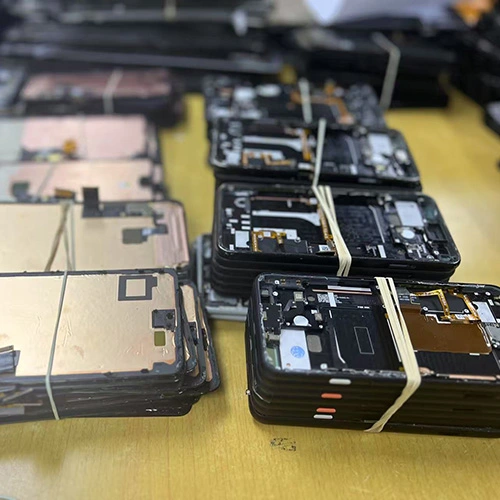Smartphones, tablets, TVs and other electronic products update fast. This makes the number of discarded LCD screens rise sharply. How to handle these electronic wastes is a key issue. They have precious metals, glass, rare metals. It matters for resource recycling and environmental protection. Modern LCD Buyback technology processes "electronic waste" through multiple steps. It turns them into reusable resources. This helps the circular economy develop.

Disassembly and separation: the first step in material recycling.
LCD Buyback begins with mechanical disassembly and physical separation. Through automated disassembly equipment, the LCD screen is separated from components such as the casing and circuit board and then enters the low temperature crushing stage. Liquid nitrogen is used to cool the screen to -196℃, so that the glass, polarizer, and liquid crystal layer are brittle and separated due to differences in thermal expansion coefficients, avoiding material oxidation and volatilization of harmful substances caused by high-temperature treatment. The crushed mixture is vibrated and screened to achieve preliminary sorting of glass fragments and soft materials, with a purity of more than 95%.
Material extraction: from discarded parts to high-value resources
The metals and polymer materials contained in the LCD screen are the focus of recycling. Take indium as an example. As a key rare metal for manufacturing ITO (indium tin oxide) conductive film, indium ingots with a purity of over 99% can be extracted from waste glass substrates through chemical processes such as acid leaching and ion exchange. Liquid crystal materials use organic solvent dissolution and distillation purification technology to separate reusable liquid crystal monomers; polyvinyl alcohol (PVA) film and triacetyl cellulose (TAC) film in polarizers can be put into production again as optical film raw materials after cleaning and drying.
Recycling: Implementation of closed-loop circulation
Recycled glass fragments can be made into new glass substrates after grinding, cleaning and high-temperature smelting; the extracted metal materials directly enter the supply chain of the electronics manufacturing industry for the production of new LCD screens or semiconductor devices. Some companies have achieved a high proportion of recycled materials, such as mixing recycled glass with virgin materials to produce TV backplane glass, reducing dependence on natural quartz sand. In addition, the wastewater and waste gas generated during the recycling process are treated by membrane separation, activated carbon adsorption and other technologies to ensure zero pollution emissions.
Technological breakthrough: intelligence and greening go hand in hand
At present, LCD Buyback technology is upgrading towards intelligence and low energy consumption. The AI visual recognition system can automatically distinguish different types of screens and optimize the disassembly path; microwave processing technology uses high-frequency electromagnetic waves to accelerate material decomposition, increasing recycling efficiency by more than 30%. The WEEE (waste electrical and electronic equipment) directive promoted by the European Union requires companies to assume recycling responsibilities and promote the establishment of a full-chain collaboration model of "producers-recyclers-material manufacturers" to ensure maximum resource utilization.
LCD Buyback and reuse is not only the key to solving electronic waste pollution, but also an important part of resource strategy. With the iteration of technology and the improvement of policies, more discarded LCD screens will be able to achieve a "product-to-product" cycle in the future, injecting new momentum into the development of the green economy.





